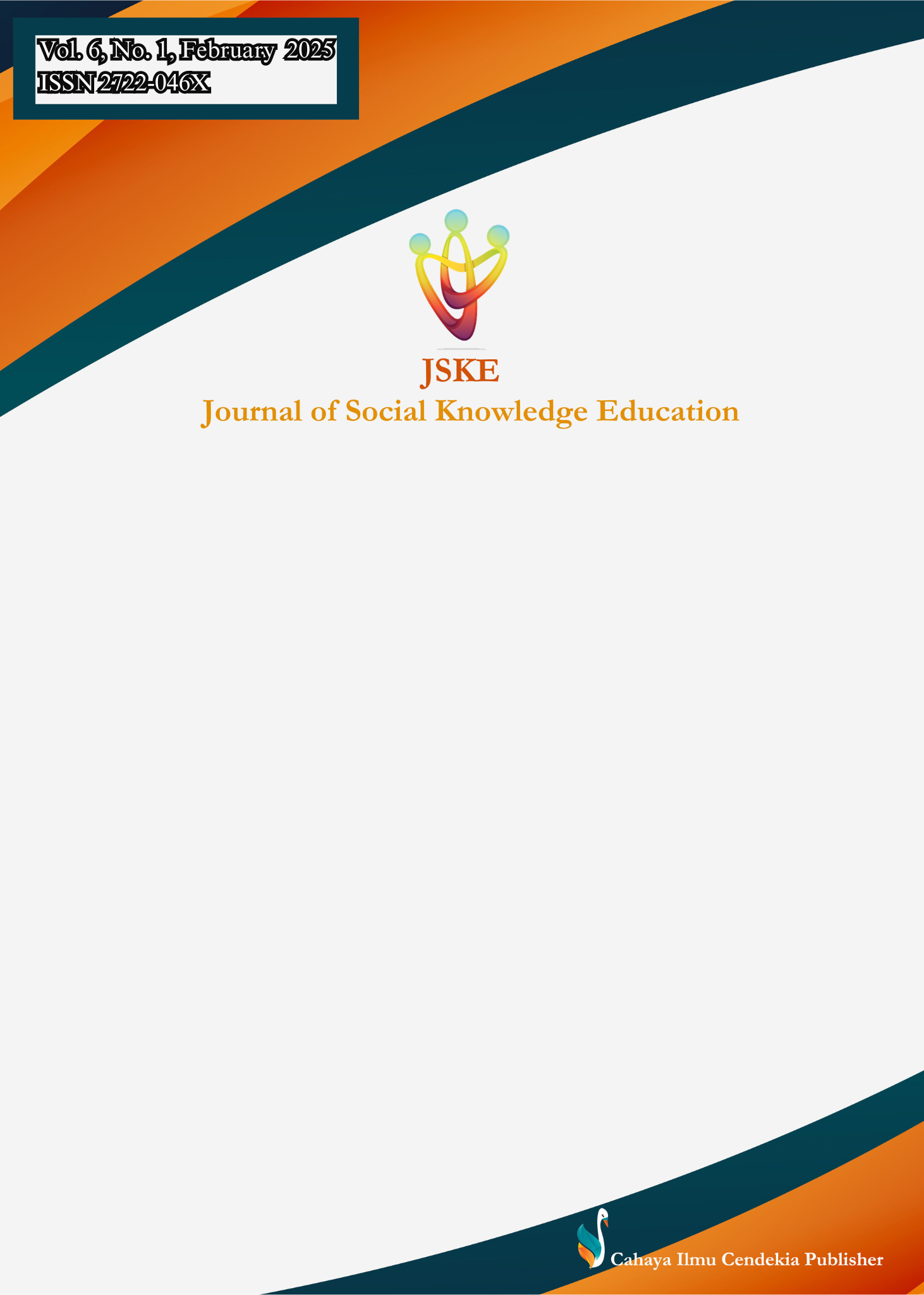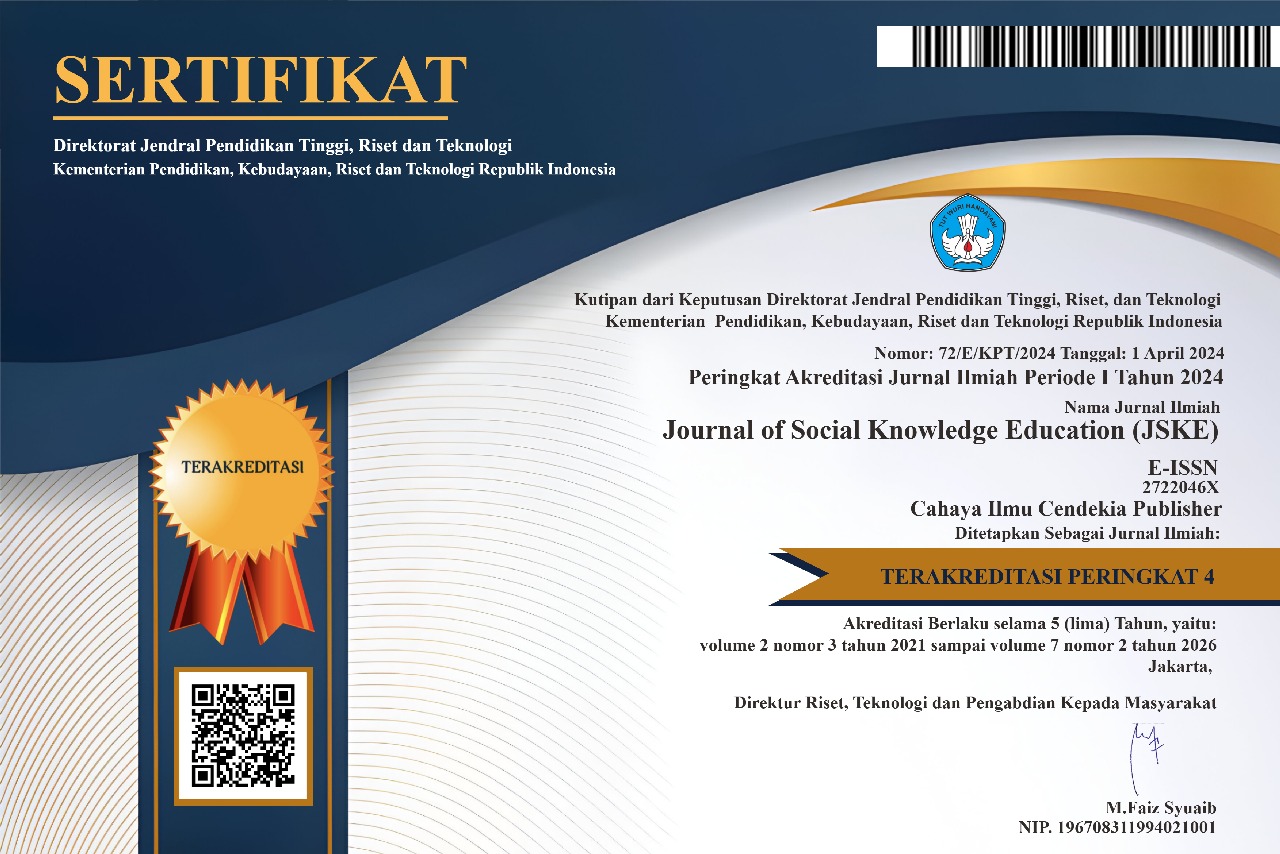Enhancing Disaster and Emergency Preparedness in Schools: An Examination of Management Knowledge and Practices Among Elementary Educators
Abstract
Purpose of the study: This study aims to assess disaster management knowledge and practices among elementary school teachers in Selected Schools in Cotabato, Philippines, with a focus on preparedness, safety prioritization, and response strategies.
Methodology: A quantitative research design was applied using a researcher-made survey questionnaire, validated with Cronbach's alpha values (0.85 and 0.91) to ensure reliability. Simple random sampling, supported by Slovin’s formula, was used to select 70 respondents from five elementary schools, with survey data gathered via school-provided teacher lists.
Main Findings: The study found that teachers possess good disaster management knowledge and are prepared with essential supplies but need a stronger focus on personal safety. Awareness is high regarding drought impacts and water conservation, but improvements are needed in early warning systems and device installations.
Novelty/Originality of this study: This study provides targeted insights into specific preparedness gaps in school disaster management, especially in early warning and response capabilities. Its findings contribute to disaster readiness by suggesting practical actions that enhance teachers’ skills, align with local needs, and foster community involvement in preparedness efforts.
References
E. Widowati, A. H. Sutomo, and W. Istiono, “Are Elementary Schools Ready for Disaster Preparedness and Safety?,” in E3S Web of Conferences, EDP Sciences, 2021, p. 01087.
H. Bahmani, Y. Ao, D. Yang, and D. Wang, “Students’ evacuation behavior during an emergency at schools: A systematic literature review,” International journal of disaster risk reduction, vol. 87, p. 103584, 2023.
A. A. Shah, W. Wu, Z. Gong, I. Pal, and J. Khan, “Multidimensional six-stage model for flood emergency response in schools: A case study of Pakistan,” Natural Hazards, vol. 105, no. 2, pp. 1977–2005, 2021.
S. S. Miresmaeeli, N. Esmaeili, S. S. Ashlaghi, and Z. A. Dolatabadi, “Disaster risk assessment among Iranian exceptional schools,” Disaster Med Public Health Prep, vol. 16, no. 2, pp. 678–682, 2022.
S. Mirzaei et al., “Design and psychometric evaluation of schools’ resilience tool in emergencies and disasters: A mixed-method,” PLoS One, vol. 16, no. 7, p. e0253906, 2021.
E. A. Opabola, C. Galasso, T. Rossetto, E. Meilianda, Y. Idris, and S. Nurdin, “Investing in disaster preparedness and effective recovery of school physical infrastructure,” International journal of disaster risk reduction, vol. 90, p. 103623, 2023.
H. Kawasaki, S. Yamasaki, M. Kurokawa, H. Tamura, and K. Sonai, “Relationship between teachers’ awareness of disaster prevention and concerns about disaster preparedness,” Sustainability, vol. 14, no. 13, p. 8211, 2022.
S. A. Poblador and R. J. Tagare, “Phenomenological Probe on Senior High School Teachers’ Experiences in Teaching Sports Track During the Transition Years of Philippine K To 12,” Sportis. Scientific Journal of School Sport, Physical Education and Psychomotricity, vol. 9, no. 1, pp. 20–40, 2023, doi: 10.17979/sportis.2023.9.1.9203.
R. Yusuf, I. Fajri, and S. A. Gani, “Disaster education in disaster-prone schools: a systematic review,” in IOP Conference Series: Earth and Environmental Science, IOP Publishing, 2022, p. 012034.
R. D. Dela Cruz and R. C. G. Ormilla, “Disaster risk reduction management implementation in the public elementary schools of the department of education, Philippines,” International Journal of Disaster Risk Management, vol. 4, no. 2, pp. 1–15, 2022.
M. K. Rañeses, A. Chang-Richards, J. Richards, and J. Bubb, “Measuring the level of disaster preparedness in Auckland,” Procedia Eng, vol. 212, pp. 419–426, 2018.
N. D. Baker and L. Grant Ludwig, “Disaster preparedness as social control,” Crit Policy Stud, vol. 12, no. 1, pp. 24–43, 2018.
S. Appleby-Arnold, N. Brockdorff, I. Jakovljev, and S. Zdravković, “Applying cultural values to encourage disaster preparedness: Lessons from a low-hazard country,” International journal of disaster risk reduction, vol. 31, pp. 37–44, 2018.
J. V Castañeda, N. C. Bronfman, P. C. Cisternas, and P. B. Repetto, “Understanding the culture of natural disaster preparedness: exploring the effect of experience and sociodemographic predictors,” Natural Hazards, vol. 103, pp. 1881–1904, 2020.
P. J. B. Ongcoy and R. L. Tagare, “The Role of Social Support in Shaping Students’ Goal Achievement,” vol. 31, no. 1, 2024.
J. W. Creswell, “Research methods,” JW Creswell, Research design: qualitative, quantitative and mixed methods approaches, pp. 15–17, 2009.
M. L. Patten, Understanding research methods: An overview of the essentials. Routledge, 2016.
L. R. Gay, G. E. Mills, and P. W. Airasian, Educational research: Competencies for analysis and applications. Pearson, 2012.
J. M. O. M. Smith JA, “Doing interpretative phenomenological analysis. In: Murray M, Chamberlain K, editors. Qualitative health psychology: theories and methods. ,” London (UK): Sage Publications, p. 218, 1999.
M. Nasreen, K. M. Hossain, and M. M. Khan, Coastal Disaster Risk Management in Bangladesh. Routledge, London, 2023.
F. McCallum and D. Price, “Well teachers, well students,” The Journal of Student Wellbeing, vol. 4, no. 1, pp. 19–34, 2010.
A. Nashte, P. K. Agrawal, D. Patil, N. Parati, U. T. Kumbhar, and N. Shelke, “Examining the Ethics of Public Health Interventions: Balancing Individual Rights and Collective Well-being,” South East Eur J Public Health, pp. 150–161, 2023.
T. E. Drabek, “Social dimensions of disaster,” 2004, Emmitsburg, Maryland: Emergency Management Institute, Federal Emergency ….
J. Drury, C. Cocking, and S. Reicher, “Everyone for themselves? A comparative study of crowd solidarity among emergency survivors,” British Journal of Social Psychology, vol. 48, no. 3, pp. 487–506, 2009.
N. Narayanan et al., “Disaster preparedness: biological threats and treatment options,” Pharmacotherapy: The journal of human pharmacology and drug therapy, vol. 38, no. 2, pp. 217–234, 2018.
R. Das, “Disaster preparedness for better response: Logistics perspectives,” International journal of disaster risk reduction, vol. 31, pp. 153–159, 2018.
B. Ryan, K. A. Johnston, M. Taylor, and R. McAndrew, “Community engagement for disaster preparedness: A systematic literature review,” International journal of disaster risk reduction, vol. 49, p. 101655, 2020.
L. J. Labrague et al., “Disaster preparedness among nurses: a systematic review of literature,” Int Nurs Rev, vol. 65, no. 1, pp. 41–53, 2018.
G. Erbeyoğlu and Ü. Bilge, “A robust disaster preparedness model for effective and fair disaster response,” Eur J Oper Res, vol. 280, no. 2, pp. 479–494, 2020.
N. L. Munasinghe and K. Matsui, “Examining disaster preparedness at Matara district general hospital in Sri Lanka,” International Journal of Disaster Risk Reduction, vol. 40, p. 101154, 2019.
M. A. Tkachuck, S. E. Schulenberg, and E. C. Lair, “Natural disaster preparedness in college students: Implications for institutions of higher learning,” Journal of American college health, vol. 66, no. 4, pp. 269–279, 2018.
A. D. R. Center, “Sendai framework for disaster risk reduction 2015–2030,” United Nations Office for Disaster Risk Reduction: Geneva, Switzerland, 2015.
K. R. Ronan, K. Crellin, D. M. Johnston, K. Finnis, D. Paton, and J. Becker, “Promoting child and family resilience to disasters: Effects, interventions, and prevention effectiveness,” Child Youth Environ, vol. 18, no. 1, pp. 332–353, 2008.
A.-U.- Rahman, A. N. Khan, and R. Shaw, Disaster risk reduction approaches in Pakistan. 2015.
N. M. Samsuddin, R. Takim, A. H. Nawawi, and S. N. A. S. Alwee, “Disaster preparedness attributes and hospital’s resilience in Malaysia,” Procedia Eng, vol. 212, pp. 371–378, 2018.
U. S. DHS, “Federal Emergency Management Agency (FEMA).(2017),” National Incident Management System.
M. Titko and J. Ristvej, “Assessing importance of disaster preparedness factors for sustainable disaster risk management: The case of the Slovak Republic,” Sustainability, vol. 12, no. 21, p. 9121, 2020.
D. Kyne et al., “Empirical evaluation of disaster preparedness for hurricanes in the Rio Grande Valley,” Progress in disaster science, vol. 5, p. 100061, 2020.
S. L. Cutter et al., “A place-based model for understanding community resilience to natural disasters,” Global environmental change, vol. 18, no. 4, pp. 598–606, 2008.
G. Taskiran and U. Baykal, “Nurses’ disaster preparedness and core competencies in Turkey: a descriptive correlational design,” Int Nurs Rev, vol. 66, no. 2, pp. 165–175, 2019.
M. L. M. I. Verheul and M. L. A. Dückers, “Defining and operationalizing disaster preparedness in hospitals: a systematic literature review,” Prehosp Disaster Med, vol. 35, no. 1, pp. 61–68, 2020.
Copyright (c) 2025 Allyza Ross Manuel, Elpedio Arias, Marlene Orfrecio, Norge Martinez, Vinus Java, Moreno Jr Java, Cheeze Janito, Ruben Jr Tagare

This work is licensed under a Creative Commons Attribution 4.0 International License.
Authors who publish with this journal agree to the following terms:
- Authors retain copyright and acknowledge that the Journal of social knowledge education (JSKE) is the first publisher licensed under a Creative Commons Attribution 4.0 International License.
- Authors are able to enter into separate, additional contractual arrangements for the non-exclusive distribution of the journal's published version of the work (e.g., post it to an institutional repository or publish it in a book), with an acknowledgment of its initial publication in this journal.
- Authors are permitted and encouraged to post their work online (e.g., in institutional repositories or on their website) prior to and during the submission process, as it can lead to productive exchanges and earlier and greater citation of published work.







.png)
.png)















